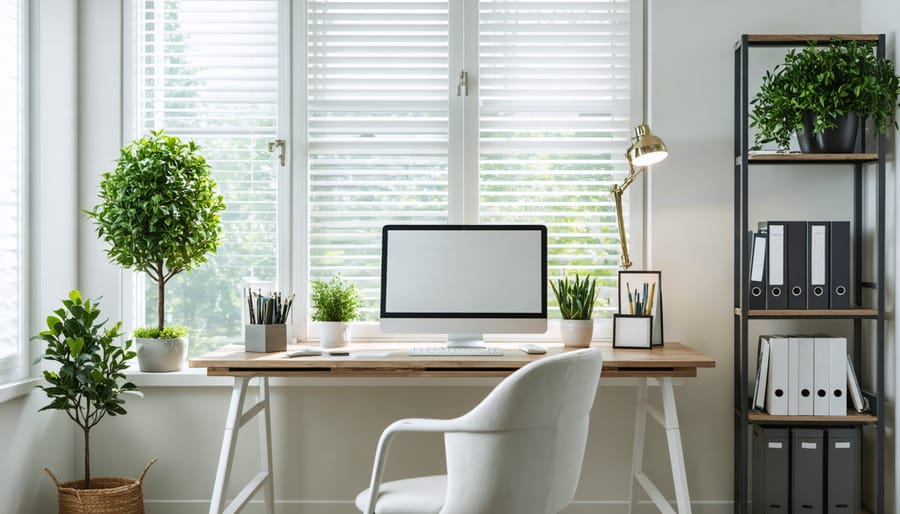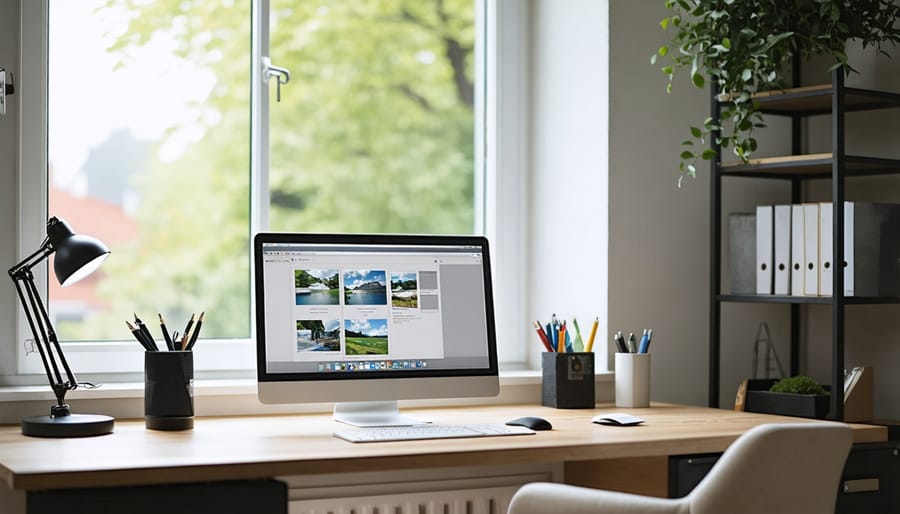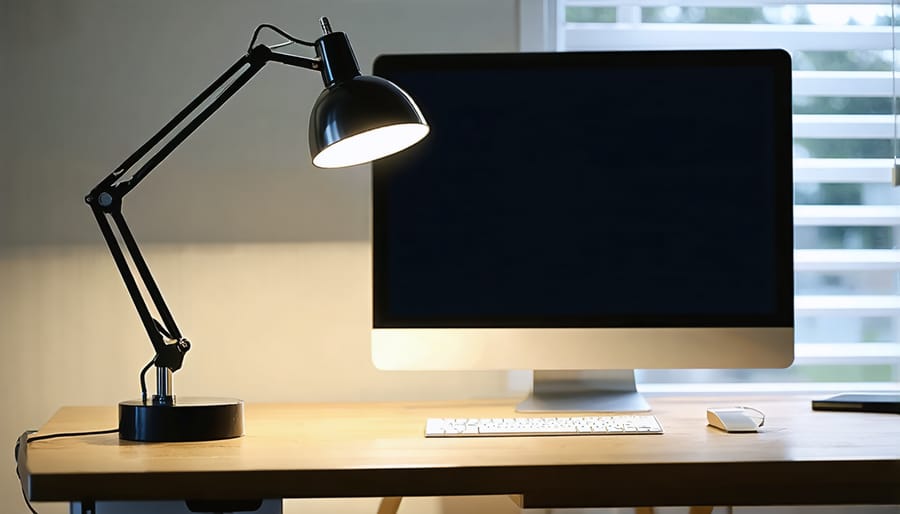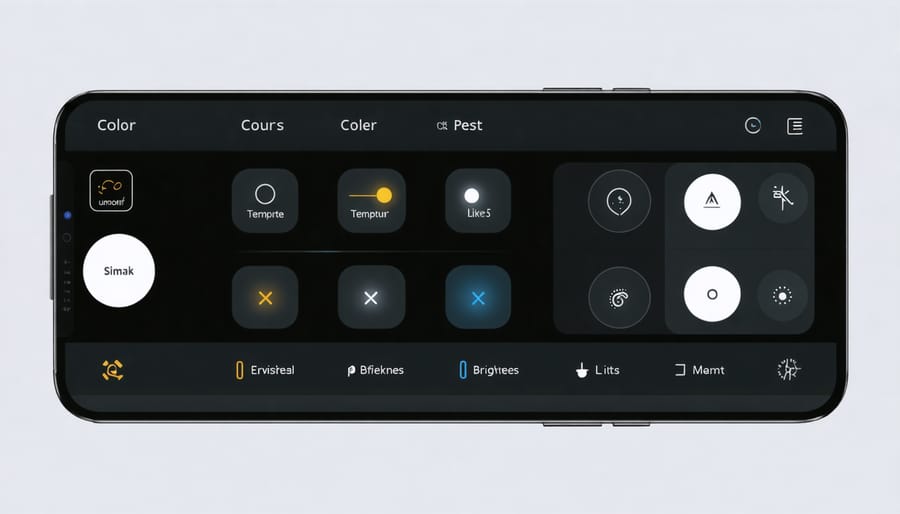
Perfect Home Office Lighting That Won’t Strain Your Eyes (Or Your Wallet)
Transform your spare room or corner into a productivity powerhouse with an ergonomic workspace setup that maximizes focus and comfort. Position your desk perpendicular to windows to minimize screen glare while capitalizing on natural light. Mount adjustable LED task lighting at a 45-degree angle above your workspace to eliminate shadows and reduce eye strain. Create distinct zones within your space—a primary work area, reference station, and brainstorming corner—to maintain organization and workflow efficiency. Install cable management solutions beneath your desk to keep technology organized and maintain a clutter-free environment that enhances concentration. Select furniture that adapts to your body’s needs, including a height-adjustable desk and supportive chair with proper lumbar support. Incorporate natural elements like plants and sustainable materials to boost well-being and creative thinking while working from home.
Natural Light: Your Home Office’s Best Friend
Window Placement and Arrangement
Strategic window placement can dramatically maximize your home office space while creating an energizing work environment. Position your desk perpendicular to windows whenever possible to minimize glare on your screen while still benefiting from natural light. This arrangement helps reduce eye strain and maintains a connection with the outdoors.
Consider using adjustable window treatments to control light throughout the day. Light-filtering roller shades or cellular blinds offer flexibility, allowing you to modify natural light levels as needed. For south-facing windows that receive intense sunlight, installing UV-blocking window film can help regulate temperature and protect your equipment from harmful rays.
If your workspace has multiple windows, try to position yourself between them for balanced lighting. When direct sunlight becomes an issue, semi-sheer curtains can diffuse harsh rays while maintaining brightness. For rooms with limited window access, placing a large mirror opposite the window can help bounce natural light deeper into your space, creating a brighter, more inviting atmosphere.
Remember to keep window sills clear of obstacles to maximize natural light flow and maintain easy access to your window treatments.

Controlling Glare and Heat
Managing sunlight in your workspace is crucial for both comfort and productivity. While natural light is beneficial, too much can create uncomfortable glare on your screens and raise room temperature significantly. Start by installing adjustable window treatments like cellular shades or light-filtering curtains that can be easily modified throughout the day as the sun moves.
For a quick fix, consider applying anti-glare window film, which reduces both brightness and heat while maintaining visibility. Position your desk perpendicular to windows rather than directly facing them to minimize direct glare on your screen. If repositioning isn’t possible, invest in an anti-glare screen protector for your monitor.
To combat heat, consider installing reflective blinds or thermal curtains that block UV rays. A small desk fan or portable air conditioner can provide targeted cooling without affecting your entire home’s temperature. For a natural approach, add indoor plants near windows – they can help filter sunlight and create a more comfortable microclimate in your workspace. Remember to keep your equipment away from direct sunlight to prevent overheating and potential damage.
Task Lighting That Works as Hard as You Do

Desk Lamps and Reading Lights
Proper task lighting is essential for preventing eye strain and maintaining productivity in your workspace. A well-chosen desk lamp can make all the difference when you’re working on detailed tasks or reading documents.
LED desk lamps are the current gold standard, offering adjustable brightness levels and color temperatures to match your needs throughout the day. Look for models with flexible arms that allow you to direct light exactly where you need it. Many modern options include USB charging ports and touch controls for added convenience.
Position your desk lamp on the opposite side of your writing hand to prevent shadows, and ensure the light source is slightly above eye level to minimize glare on your screen. For optimal coverage, the lamp’s head should be about 15 inches above your work surface and angled at approximately 30 degrees.
Consider getting a secondary reading light for reference materials or books. Clip-on lights are perfect for tight spaces, while floor lamps with adjustable heads work well for larger areas. If you frequently work with physical documents, a lamp with a wide beam spread will help illuminate your entire workspace evenly.
Smart desk lamps are worth considering if you want to automate your lighting schedule or integrate with your home office ecosystem. These can adjust automatically based on the time of day or sync with your video conferencing setup for optimal lighting during calls.
Monitor and Screen Backlighting
Your monitor’s backlight can significantly impact eye strain during long work sessions. Position your screen so it’s perpendicular to any windows to minimize glare, and adjust the brightness to match your room’s ambient lighting. A good rule of thumb is to set your screen brightness similar to a white piece of paper in your workspace.
Consider using bias lighting – a light source placed behind your monitor – to reduce the contrast between your screen and the surrounding area. This simple addition can dramatically decrease eye fatigue and make your workspace more comfortable. You can easily create this setup using LED strips or a small desk lamp positioned behind your monitor.
Most modern monitors come with blue light filtering features, but you can enhance this with software solutions like f.lux or built-in operating system options. These automatically adjust your screen’s color temperature throughout the day, matching natural light patterns and helping maintain your circadian rhythm.
For multi-monitor setups, ensure all screens are set to matching brightness and color temperatures. Position them at the same height and distance from your eyes, ideally at arm’s length. If you’re using a laptop alongside a monitor, consider a laptop stand to align both screens at eye level.
Remember to take regular breaks using the 20-20-20 rule: every 20 minutes, look at something 20 feet away for 20 seconds. This helps reduce eye strain regardless of your lighting setup.
Ambient Lighting for All-Day Comfort
Overhead Lighting Solutions
Proper overhead lighting can transform your workspace from dim and dreary to bright and energizing. Recessed can lights offer a clean, modern look while providing even illumination across your work area. These fixtures sit flush with the ceiling, making them ideal for rooms with lower heights or where you want to maintain a minimalist aesthetic.
For a more traditional approach, flush-mount or semi-flush ceiling fixtures can serve as attractive focal points while delivering ample light. LED versions of these fixtures are particularly energy-efficient and often include dimming capabilities, allowing you to adjust light levels throughout the day.
Consider installing track lighting for maximum flexibility. These systems let you direct light exactly where you need it and can be especially useful in larger workspaces or areas with multiple desk configurations. Many modern track systems feature adjustable heads and compatibility with different bulb types.
For the best results, layer your overhead lighting with task lighting. Install your main ceiling fixture on a dimmer switch to control ambient light levels, and complement it with desk lamps or wall-mounted lights for focused work. This combination helps reduce eye strain and creates a more comfortable working environment.
Wall-Mounted and Floor Lamps
While overhead lighting provides a good foundation, wall-mounted and floor lamps are essential for eliminating shadows and creating the perfect lighting balance in your workspace. These supplementary light sources offer flexibility and can be adjusted throughout the day as your lighting needs change.
Wall-mounted swing arm lamps are particularly useful for desk work, as they can be positioned directly over your workspace and moved out of the way when not needed. Look for models with adjustable heads to direct light exactly where you need it. Installing these at around shoulder height on either side of your desk helps reduce eye strain and creates even illumination across your work surface.
Floor lamps with adjustable heights and heads serve as excellent task lighting solutions, especially when desk space is limited. Consider models with built-in dimming features to adjust brightness levels. Arc floor lamps are particularly versatile, as they can reach over your desk without taking up valuable workspace.
For maximum flexibility, combine both types of supplementary lighting. Position a floor lamp in the corner of your room for ambient lighting, and add wall-mounted lamps near your desk for focused task lighting. This combination ensures complete coverage and allows you to create different lighting zones within your workspace.
Smart Lighting Technology for Your Workspace
Automated Lighting Systems
Transforming your workspace lighting has never been easier thanks to modern smart office technology. Automated lighting systems offer unprecedented control over your work environment, helping you maintain productivity throughout the day.
Smart bulbs are the foundation of any automated lighting setup. These WiFi-enabled lights can be controlled through your smartphone or voice assistant, allowing you to adjust brightness and color temperature with simple commands. Many popular brands like Philips Hue and LIFX offer easy-to-install options that work with existing fixtures.
Creating lighting schedules is a game-changer for your daily routine. Program your lights to gradually brighten in the morning, mimicking natural sunrise to help you start your day energized. During work hours, maintain cool, bright light to enhance focus, then transition to warmer tones as evening approaches to help wind down.
Motion sensors can automatically illuminate your workspace when you enter and power down when you leave, saving energy and adding convenience. For video calls, preset lighting scenes ensure you look professional on camera with just one tap.
Consider grouping different light sources – overhead lights, task lamps, and accent lighting – into zones. This allows you to activate perfect lighting combinations for various activities, from focused work to casual reading, without manual adjustments each time.
Color Temperature and Brightness Control
The ability to control both color temperature and brightness in your workspace can significantly impact your productivity and comfort throughout the day. Just as natural light changes from morning to evening, your artificial lighting should adapt to support your circadian rhythm and work patterns.
Start by investing in smart bulbs or adjustable LED fixtures that offer color temperature control. Morning work benefits from cooler, bluish light (5000-6500K) that mimics daylight and helps maintain alertness. As the day progresses, gradually warm your lighting to create a more relaxing atmosphere (2700-3000K), which helps reduce eye strain during evening work sessions.
For optimal brightness control, implement a layered lighting approach. Combine ambient ceiling lights with task lighting at your desk, and accent lighting to eliminate harsh shadows. Most smart lighting systems offer dimming capabilities through smartphone apps or voice commands, letting you adjust brightness levels based on your tasks and time of day.
Consider creating lighting presets for different activities: bright, cool light for detailed work; medium, neutral light for computer tasks; and warmer, dimmer light for creative work or video calls. If you’re on a budget, even basic LED desk lamps with adjustable color temperatures can make a significant difference in your workspace comfort.
Remember to match your screen brightness to your ambient lighting to reduce eye fatigue, and take regular breaks to rest your eyes, especially during long work sessions.

DIY Lighting Upgrades on a Budget
Transform your workspace lighting without breaking the bank using these creative DIY solutions. Start by maximizing natural light with strategically placed mirrors – position them opposite windows to reflect and amplify daylight throughout your space. A simple glass or acrylic desk surface can also help bounce light around your workspace.
For task lighting, consider repurposing existing lamps with LED bulbs, which use less energy and last longer. You can create a stylish desk lamp using industrial pipe fittings and LED strips, or transform mason jars into pendant lights with simple cord kits available at hardware stores. These projects typically cost under $30 and add a personal touch to your workspace.
Don’t overlook the power of reflective surfaces. Paint your walls in light, neutral colors and add metallic accents to enhance light distribution. White poster board or foam core can serve as affordable light reflectors – position them strategically to eliminate harsh shadows during video calls.
For ambient lighting, string lights aren’t just for holidays. Create a professional look by running them along ceiling corners or behind frosted panels. Battery-operated LED puck lights, available for around $15, can illuminate dark corners or serve as under-shelf lighting.
Consider light positioning carefully. Clamp lights, which cost about $10, can be attached to shelves or desk edges, providing adjustable task lighting without permanent installation. Use white paper or fabric as DIY diffusers to soften harsh direct light.
Remember to layer your lighting sources – combine upward-facing lights for ambient illumination with focused task lighting for your work surface. This professional approach to lighting design can be achieved with simple, affordable materials and basic DIY skills.
Creating an effective home workspace is a journey that combines thoughtful planning with personal touches. By focusing on proper lighting, ergonomic furniture, and smart organization, you can transform any corner of your home into a productive work environment. Remember that your workspace should reflect your working style while maintaining functionality. Start with the basics we’ve discussed, like proper desk positioning and lighting, then gradually implement more advanced solutions as needed. Don’t feel pressured to create the perfect setup immediately – take time to understand what works best for you. The key is to create a space that not only looks professional but also supports your productivity and well-being. With these guidelines in mind, you’re well-equipped to design a workspace that will help you thrive in your home office environment.
